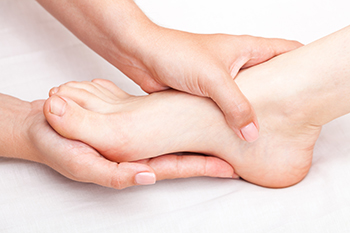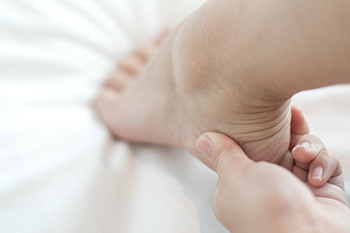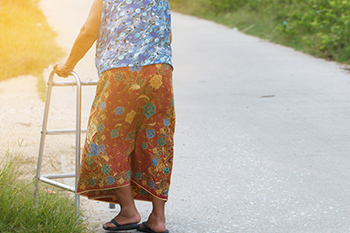Items filtered by date: April 2022
Overuse Can Cause Stress Fractures

The long bones that are found in the midfoot are referred to as the metatarsals. A stress fracture is a hairline crack in the bones, and these specific bones can be affected. This type of fracture can happen as a result of overuse, and is common among patients who enjoy running. Many people increase their running speed and mileage too quickly, and this can put extreme pressure on the bones of the feet. Additionally, excess pressure exerted on the feet may come from wearing shoes that do not fit correctly. It is important for stress fractures to be properly diagnosed, and this is generally done by having an X-ray taken. Relief can be found when the affected foot is elevated, and a cast or a boot may be worn for stability. If you have a stress fracture of the foot, it is strongly suggested that you are under the care of a podiatrist who can properly treat this condition.
Activities where too much pressure is put on the feet can cause stress fractures. To learn more, contact Glenn Aufseeser, DPM from Lakewood Foot and Ankle Specialists. Our doctor can provide the care you need to keep your pain free and on your feet.
Dealing with Stress Fractures of the Foot and Ankle
Stress fractures occur in the foot and ankle when muscles in these areas weaken from too much or too little use. The feet and ankles then lose support when walking or running from the impact of the ground. Since there is no protection, the bones receive the full impact of each step. Stress on the feet can cause cracks to form in the bones, thus creating stress fractures.
What Are Stress Fractures?
Stress fractures occur frequently in individuals whose daily activities cause great impact on the feet and ankles. Stress factors are most common among:
- Runners
- People affected with Osteoporosis
- Tennis or basketball players
- Gymnasts
- High impact workouts
Symptoms
Pain from the fractures occur in the area of the fractures and can be constant or intermittent. It will often cause sharp or dull pain with swelling and tenderness. Engaging in any kind of activity which involves high impact will aggravate pain.
If you have any questions please feel free to contact our offices located in Lakewood and Manchester Township, NJ . We offer the newest diagnostic and treatment technologies for all your foot and ankle needs.
Get Professional Care for a Broken Foot or Ankle
Where Heel Pain Occurs May Provide Clues to Its Cause

Heel pain can be caused by a variety of conditions, with the most common one being plantar fasciitis: an inflammation of the plantar fasciitis tissue on the bottom of the foot. Identifying where the pain is specifically located in the heel can sometimes help your podiatrist diagnose your condition. For instance, plantar fasciitis usually causes pain in the bottom/middle of the heel which is at its worst when you first wake up in the morning. Other conditions, such as heel stress fractures, nerve issues, or heel pad atrophy can also cause pain on the bottom of the heel. Pain in the back of the heel may be caused by problems with your Achilles tendon, which connects the heel bone to the calf muscles. These conditions include Achilles tendinopathy/tendinitis, which is usually an overuse injury to the tendon, Haglund’s deformity, which produces a bump at the back of the heel due to shoes exerting pressure on the tendon, and Sever’s disease, which is due to stress on the heel’s growth plate in growing children. Pain in the middle of the heel can sometimes be caused by an entrapped nerve in the ankle (tarsal tunnel syndrome). Sinus tarsi syndrome, typically due to flat feet or following an ankle sprain, can cause pain in the middle/side portion of the heel. Any type of heel pain should be examined by a podiatrist to receive proper diagnosis and treatment.
Many people suffer from bouts of heel pain. For more information, contact Glenn Aufseeser, DPM of Lakewood Foot and Ankle Specialists. Our doctor can provide the care you need to keep you pain-free and on your feet.
Causes of Heel Pain
Heel pain is often associated with plantar fasciitis. The plantar fascia is a band of tissues that extends along the bottom of the foot. A rip or tear in this ligament can cause inflammation of the tissue.
Achilles tendonitis is another cause of heel pain. Inflammation of the Achilles tendon will cause pain from fractures and muscle tearing. Lack of flexibility is also another symptom.
Heel spurs are another cause of pain. When the tissues of the plantar fascia undergo a great deal of stress, it can lead to ligament separation from the heel bone, causing heel spurs.
Why Might Heel Pain Occur?
- Wearing ill-fitting shoes
- Wearing non-supportive shoes
- Weight change
- Excessive running
Treatments
Heel pain should be treated as soon as possible for immediate results. Keeping your feet in a stress-free environment will help. If you suffer from Achilles tendonitis or plantar fasciitis, applying ice will reduce the swelling. Stretching before an exercise like running will help the muscles. Using all these tips will help make heel pain a condition of the past.
If you have any questions please contact our offices located in Lakewood and Manchester Township, NJ . We offer the newest diagnostic and treatment technologies for all your foot and ankle needs.
Why Exercises Are Important After an Ankle Injury
Recovering from an ankle injury or ailment can result in a long period of inactivity, which can cause the leg and ankle muscles to weaken. Before returning to normal activity levels, such as sports, work, or everyday errands/chores, experts often recommend beginning a course of light exercises to increase strength and flexibility in the joint. When embarking on such an endeavor, it is suggested that you consult a podiatrist who can give you guidance on which exercises are most beneficial for your particular injury and help plan a schedule for adding repetitions and frequency. Many simple exercises that benefit the ankle joint can be performed sitting in a chair. It is usually suggested to do three repetitions of each exercise two or three times a day to start, gradually building up from there. It is important not to re-injure the joint as you continue to strengthen it. Pay attention to the pain level, and stop if you feel severe discomfort or new pain. Patients who are recovering from an ankle injury should consult with a podiatrist for a proper recovery plan.
Ankle pain can be caused by a number of problems and may be potentially serious. If you have ankle pain, consult with Glenn Aufseeser, DPM from Lakewood Foot and Ankle Specialists. Our doctor will assess your condition and provide you with quality foot and ankle treatment.
Ankle pain is any condition that causes pain in the ankle. Due to the fact that the ankle consists of tendons, muscles, bones, and ligaments, ankle pain can come from a number of different conditions.
Causes
The most common causes of ankle pain include:
- Types of arthritis (rheumatoid, osteoarthritis, and gout)
- Ankle sprains
- Broken ankles
- Achilles tendonitis
- Achilles tendon rupture
- Stress fractures
- Bursitis
- Tarsal tunnel syndrome
- Plantar fasciitis
Symptoms
Symptoms of ankle injury vary based upon the condition. Pain may include general pain and discomfort, swelling, aching, redness, bruising, burning or stabbing sensations, and/or loss of sensation.
Diagnosis
Due to the wide variety of potential causes of ankle pain, podiatrists will utilize a number of different methods to properly diagnose ankle pain. This can include asking for personal and family medical histories and of any recent injuries. Further diagnosis may include sensation tests, a physical examination, and potentially x-rays or other imaging tests.
Treatment
Just as the range of causes varies widely, so do treatments. Some more common treatments are rest, ice packs, keeping pressure off the foot, orthotics and braces, medication for inflammation and pain, and surgery.
If you have any questions, please feel free to contact our offices located in Lakewood and Manchester Township, NJ . We offer the newest diagnostic and treatment technologies for all your foot care needs.
Ways to Keep From Falling
 Many older people are at an increased risk of falling. It is believed that one-third of people over 65, and half of people over 80, fall at least once a year. Common factors that contribute to the likelihood of falling are impaired vision, loss of balance, dizziness, muscle weakness, and low blood pressure. Also, diabetic neuropathy (which causes numbness in the feet), slick or highly polished floors (especially in the bathroom), loose rugs, poor lighting, and pathways blocked with furniture may risks. Actions like slipping on a ladder or step stool, reaching for something too high, or going down stairs may cause falls. One good way to prevent a fall is by paying attention to your surroundings. Here are some suggestions to help lessen the risk: Use non-slip mats in the bathroom, and wear shoes or slippers with non-skid soles; get help moving heavy items and carrying awkward objects; make sure hallways have adequate lighting; use a cane or walker if balance is an issue; and remove throw rugs and loose carpeting. If you are at risk of falling, it may be wise to see a podiatrist for guidance in proper footwear and an examination to make sure your feet are not part of the problem.
Many older people are at an increased risk of falling. It is believed that one-third of people over 65, and half of people over 80, fall at least once a year. Common factors that contribute to the likelihood of falling are impaired vision, loss of balance, dizziness, muscle weakness, and low blood pressure. Also, diabetic neuropathy (which causes numbness in the feet), slick or highly polished floors (especially in the bathroom), loose rugs, poor lighting, and pathways blocked with furniture may risks. Actions like slipping on a ladder or step stool, reaching for something too high, or going down stairs may cause falls. One good way to prevent a fall is by paying attention to your surroundings. Here are some suggestions to help lessen the risk: Use non-slip mats in the bathroom, and wear shoes or slippers with non-skid soles; get help moving heavy items and carrying awkward objects; make sure hallways have adequate lighting; use a cane or walker if balance is an issue; and remove throw rugs and loose carpeting. If you are at risk of falling, it may be wise to see a podiatrist for guidance in proper footwear and an examination to make sure your feet are not part of the problem.
Preventing falls among the elderly is very important. If you are older and have fallen or fear that you are prone to falling, consult with Glenn Aufseeser, DPM from Lakewood Foot and Ankle Specialists. Our doctor will assess your condition and provide you with quality advice and care.
Every 11 seconds, an elderly American is being treated in an emergency room for a fall related injury. Falls are the leading cause of head and hip injuries for those 65 and older. Due to decreases in strength, balance, senses, and lack of awareness, elderly persons are very susceptible to falling. Thankfully, there are a number of things older persons can do to prevent falls.
How to Prevent Falls
Some effective methods that older persons can do to prevent falls include:
- Enrolling in strength and balance exercise program to increase balance and strength
- Periodically having your sight and hearing checked
- Discuss any medications you have with a doctor to see if it increases the risk of falling
- Clearing the house of falling hazards and installing devices like grab bars and railings
- Utilizing a walker or cane
- Wearing shoes that provide good support and cushioning
- Talking to family members about falling and increasing awareness
Falling can be a traumatic and embarrassing experience for elderly persons; this can make them less willing to leave the house, and less willing to talk to someone about their fears of falling. Doing such things, however, will increase the likelihood of tripping or losing one’s balance. Knowing the causes of falling and how to prevent them is the best way to mitigate the risk of serious injury.
If you have any questions, please feel free to contact our offices located in Lakewood and Manchester Township, NJ . We offer the newest diagnostic and treatment technologies for all your foot care needs.


